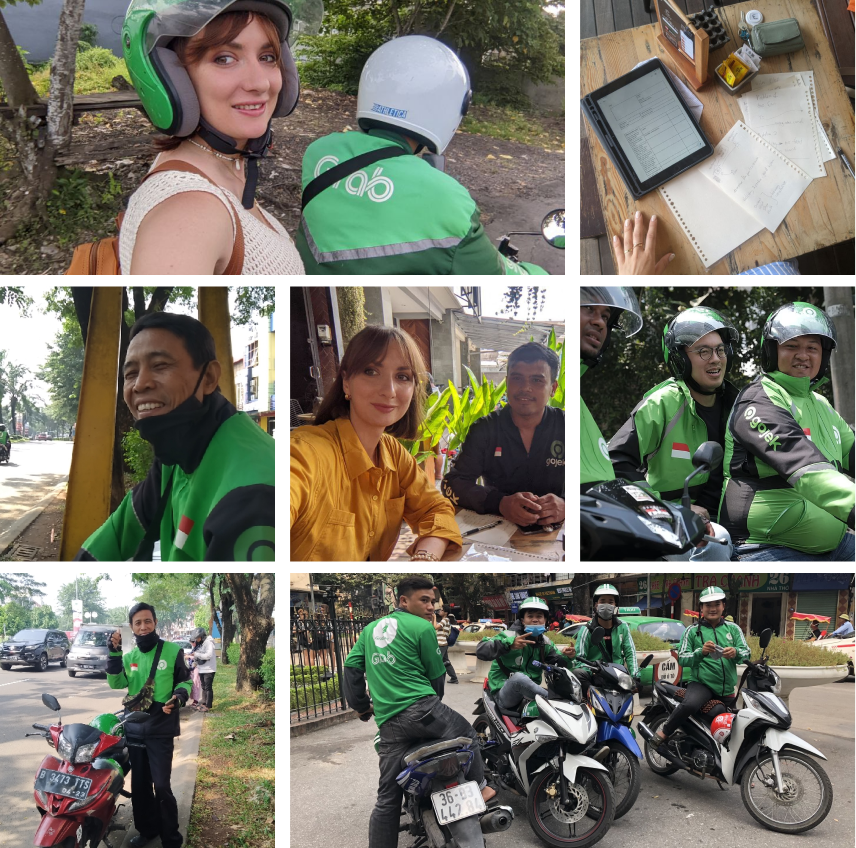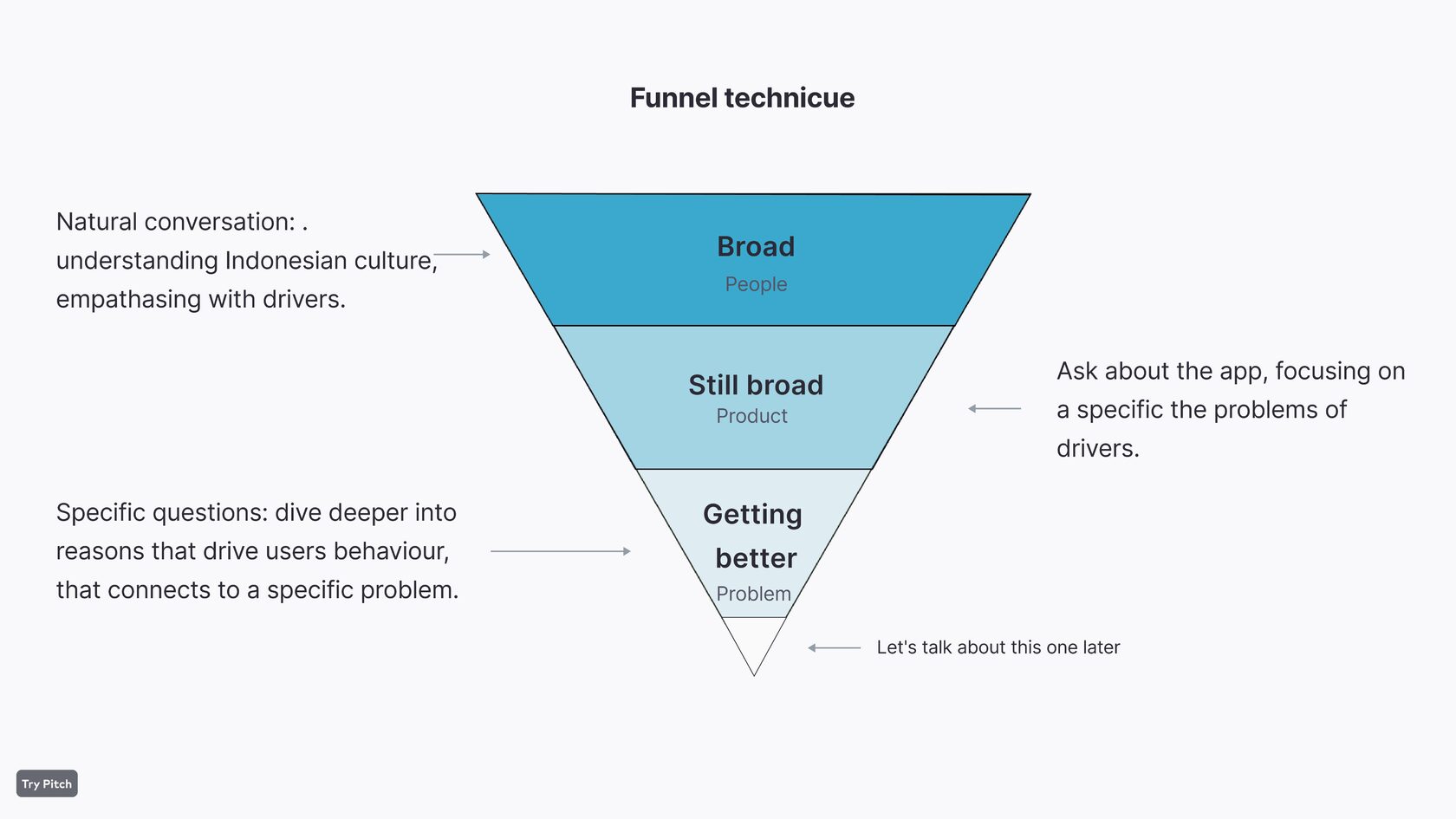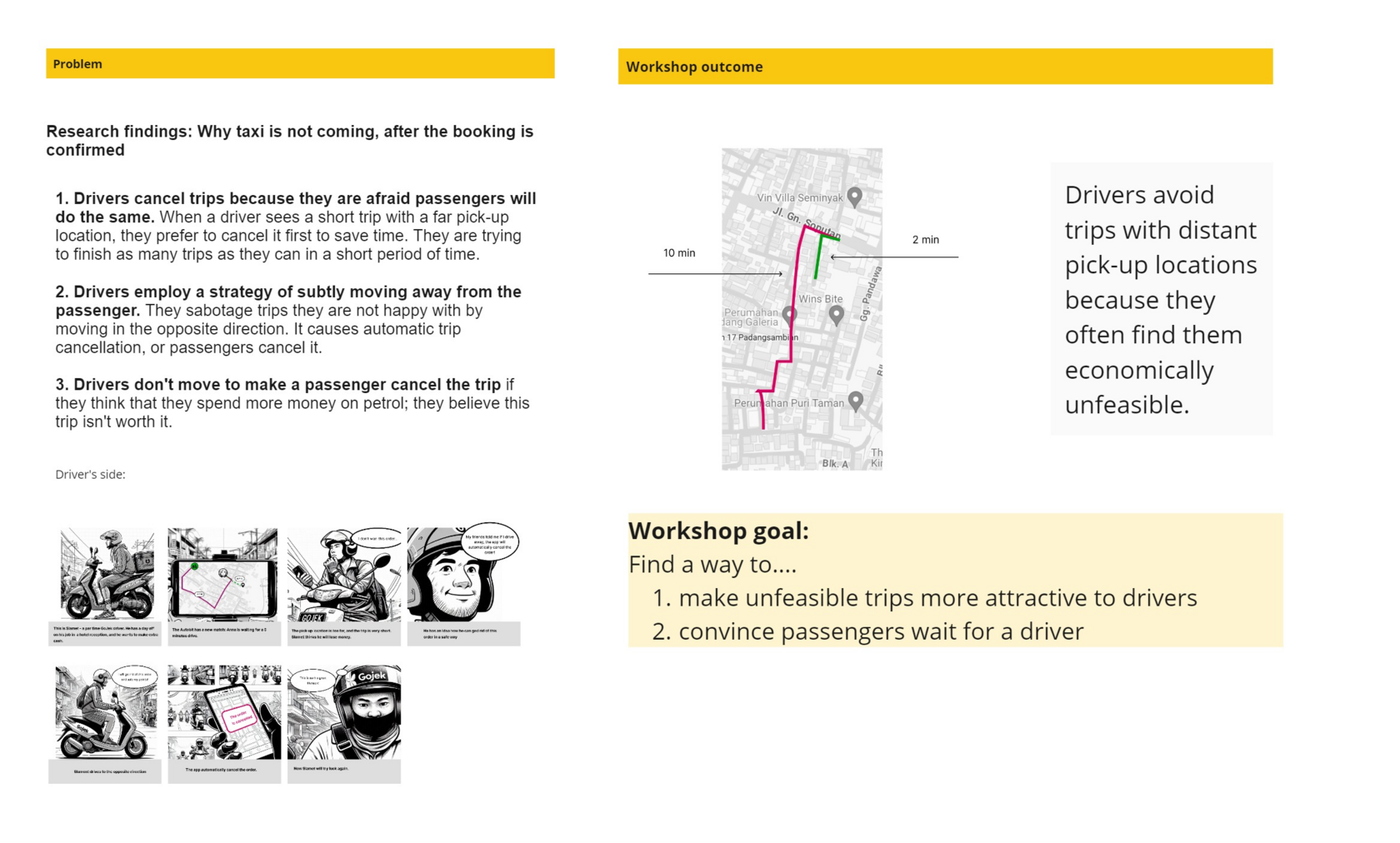While on holiday in Bali, I started using the Gojek app, primarily for taxis and food delivery. It was very convenient to have everything I needed in one app. However, I noticed a recurring issue in the mornings: drivers would accept my order but never arrive. This problem also occurred with short trips. Curious, I began talking to the drivers and discovered a pattern. Recognising a problem worth solving, I decided to develop a case study while enjoying fresh fruit bowls on my holiday.
Case study content
Research
- Contextual Inquiry research.
- Top Findings
- Google Play Reviews
- Top Findings
Proposal for redesign
- Storyboards
- HMW Workshop
- UX Design Recommendations
Research Objectives: Find out what causes drivers to cancel short trips.
Project duration: 1 month
Problem Statement: Ordering a scooter taxi could take 30+ minutes:drivers cancel trips / don't move/drive away.
I have conducted in-depth Interviews with 26 GoJek drivers observing them in a natural environment, and briefly chatted with 40 drivers from the competitive app - Grab.
Recruiting GoJek drivers faced initial hurdles due to cultural differences and mistrust. Efforts to conduct formal interviews failed as potential participants were sceptical about the value of their input, with some thinking it was an attempt to hack the GoJek app. Many drivers had low computer literacy and hadn't finished high school. Additionally, most struggled with English, requiring a voice Google translator. Monetary rewards and scheduling interviews for the next day were ineffective. Some participants were too shy or disbelieving in their ability to contribute, leading them to stop responding.
After a few rejections, I tried another approach: connecting through small talk. I ordered a taxi and conversed with the driver during the ride. This interaction helped me gauge communication ease and the language barrier. I also assessed the driver’s critical thinking and honesty. Unaware of the survey, drivers were more candid. Once I saw we could converse, I invited them for an in-depth interview.



🔍 Top Findings Contextual Inquiry research.
As I observed GoJek scooter taxi drivers navigating the bustling Indonesian traffic, it became clear that their attention is constantly in flux due to the chaotic environment and physical demands of driving. Distractions like conversations with peers and family video calls are common, posing safety risks and impacting service quality. To address this, systems like Autobit incentivize drivers with performance metrics, helping them stay focused.
Google Play reviews provide real user feedback, highlighting common issues and recurring problems. These reviews confirmed that many users encounter the same issue, decreasing their satisfaction.



I have found that all uneasy drivers' behavior is caused by dissatisfaction with a certain type of trip: short trips with a far pickup location. Drivers employ a few techniques to avoid these trips. They worry about their rating score, so they have a few techniques that help them get rid of the orders they don't like.
1. Drivers cancel trips because they are afraid passengers will do the same. When a driver sees a short trip with a far pick-up location, they prefer to cancel it first to save time. They are trying to finish as many trips as they can in a short period of time.
2. Drivers employ a strategy of subtly moving away from the passenger. They sabotage trips they are not happy with by moving in the opposite direction. It causes automatic trip cancellation, or passengers cancel it.
3. Drivers don't move to make a passenger cancel the trip if they think that they spend more money on petrol; they believe this trip isn't worth it.
4. Drivers don't move because they don't check the app. They left "Autobit" on and got distracted. This happened more often between 7 am and 10 am.
✅ Workshop Objectives
Develop and validate hypothesis solutions
Project duration: 2 days
Problem Statement: Ordering a scooter taxi could take 30+ minutes:drivers cancel trips / don't move/drive away.
The human brain processes images 60,000 times faster than text, this is why storyboards are so handy. It comes as a visual sequence that outlines a user's journey with a context and the user's feelings. It consists of illustrated frames depicting key interactions and screens from the user's perspective.
These illustrations were generated with AI.


In response to the recurring issues identified with the Gojek app, we are conducting a workshop focused on developing solutions to these challenges. By leveraging collective insights from the research, we aim to enhance the overall experience for all app users.
Goals
1) Reduce Trip Cancellations: Develop strategies to mitigate drivers' fear of passenger cancellations, particularly for short trips with distant pick-up locations, to reduce the frequency of trip cancellations.
2) Eliminate Sabotage Tactics: Create effective solutions to prevent drivers from employing tactics such as subtly moving away from passengers to cause automatic trip cancellations or induce passenger cancellations.
3) Enhance Trip Value: Formulate approaches to ensure that all trips are financially viable for drivers, addressing their concerns about the cost of petrol and the perceived value of short trips.
4) Increase Driver Engagement: Design interventions to improve driver engagement with the app, particularly during the hours of 7 am to 10 am, to prevent distractions and ensure timely responses to trip requests.



Workshop outcomes
The problem needs to be addressed to both drivers and passengers.
For the drivers:
- remind drivers that these short trips are also valuable for the system and help them to earn rewards and money
- add more points/rewards for long pick-up trips
- offer a reward (point/money)
For passengers:
- update passengers with the order progress
- offed discount/points for long waiting time
- encourage them not to cancel the trip
(!) Improve the Autobit system (needs more exploration)
- 1Improve Driver Engagement
- Implement visual reminders in the driver app emphasising the value of short trips to the system. Use motivational messages highlighting rewards and earnings from these trips.
- Increase incentives for drivers undertaking longer pick-up journeys. Display potential rewards prominently within the app.
- 2Improve Passenger Experience
- Integrate the animation with real-time updates. For example, the animation could show a character moving towards a designated point on a map, reflecting the progress of the assigned driver.
- Design a playful and informative animation to entertain passengers while they wait for a taxi. This could include a dynamic progress bar with interactive elements or a cute character representing the waiting process.
- Use the animation to provide visual feedback on the impact of waiting. For instance, the animation could change based on the length of the wait, offering rewards or encouraging messages for patience.
- Offer discounts or loyalty points to passengers experiencing extended waiting times, encouraging them to remain patient rather than canceling.
- 3Implement other System Improvement
- Explore enhancements to the Autobit system for more effective matching and trip allocation. Conduct user research to identify pain points and areas for improvement.